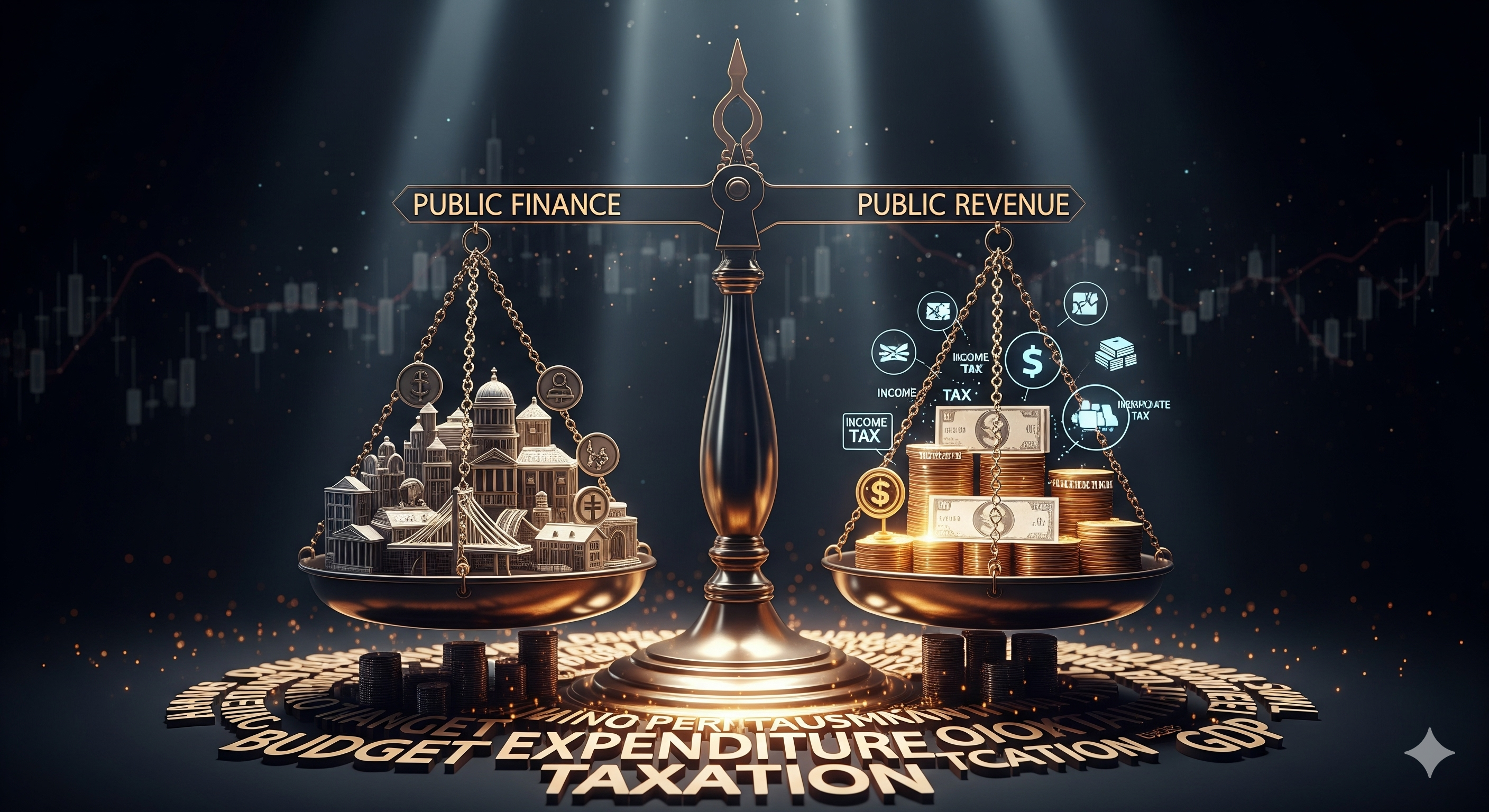Introduction
Economics is not only about markets and private enterprises; it is equally about the role of the government in mobilizing resources, spending them effectively, and influencing the economic structure of a nation. This role of the government is understood through Public Finance. Within public finance, two core concepts stand out—Public Revenue and Tax Revenue. Public revenue represents all forms of income that governments collect, while tax revenue specifically refers to the income generated through taxation.
These three concepts are fundamental in the study of economics, governance, and public policy. They help explain how governments function, how development projects are financed, and how social and economic objectives are achieved.
1. Understanding Public Finance
1.1 Definition of Public Finance
Public finance refers to the branch of economics that deals with the collection of revenue, allocation of resources, and expenditure by the government. It studies how the government raises money (through taxes, borrowing, and non-tax sources), how it spends that money on public goods and services, and how it manages deficits and surpluses.
In simpler terms, public finance is the financial management of a government at local, state, or national levels.
1.2 Importance of Public Finance
- Provision of Public Goods – Governments finance infrastructure like roads, schools, hospitals, and defense, which private markets often fail to provide.
- Redistribution of Income – Through taxation and welfare schemes, governments reduce inequality and promote social justice.
- Stabilization of Economy – Public finance helps manage inflation, unemployment, and growth cycles by regulating expenditure and revenue collection.
- Economic Development – By investing in sectors like health, education, and technology, governments lay the foundation for long-term growth.
- Correcting Market Failures – Pollution control, social security, and regulation of monopolies are financed through public funds.
1.3 Scope of Public Finance
Public finance can be divided into four key areas:
- Public Revenue – Sources of income.
- Public Expenditure – How the money is spent.
- Public Debt – Borrowing by the government to meet financial needs.
- Financial Administration – Budget preparation, audit, and fiscal rules.
2. Public Revenue
2.1 Meaning of Public Revenue
Public revenue is the income that a government collects from various sources to meet its expenditure. It includes all regular and non-regular income sources such as taxes, fees, fines, borrowings, and grants.
In short, public revenue is the inflow of funds into the government treasury.
2.2 Importance of Public Revenue
- Funding Government Operations – Salaries, defense, and administration rely on revenue inflows.
- Social Welfare Programs – Schemes like pensions, healthcare, and subsidies depend on adequate public revenue.
- Capital Formation – Revenue is used to create assets like highways, airports, and power plants.
- Maintaining Sovereignty – A financially independent government can protect its policies and people without excessive foreign dependence.
2.3 Sources of Public Revenue
Public revenue can be classified into Tax Revenue and Non-Tax Revenue.
(a) Tax Revenue
This includes all income from taxes such as income tax, corporate tax, excise duty, customs duty, service tax, and Goods and Services Tax (GST).
(b) Non-Tax Revenue
Non-tax revenue includes fees, fines, penalties, interest receipts, dividends from public enterprises, profits from state-owned companies, and grants from other governments or international institutions.
2.4 Principles of Public Revenue Collection
- Equity – Revenue collection should be fair, with the rich paying more than the poor.
- Certainty – Citizens should know how and when taxes are levied.
- Convenience – The mode of payment should not burden taxpayers.
- Economy – The cost of revenue collection should be minimal compared to the revenue generated.
3. Tax Revenue
3.1 Meaning of Tax Revenue
Tax revenue is the largest and most stable component of public revenue. It refers to the compulsory payments made by individuals and businesses to the government without expecting direct benefits in return. Taxes are imposed by law and failure to pay them results in penalties or legal consequences.
3.2 Characteristics of Tax Revenue
- Compulsory Nature – Taxes are not voluntary.
- No Direct Return – Citizens do not get direct benefits equivalent to their tax payments.
- Legal Obligation – Taxes are backed by the authority of law.
- Used for Public Welfare – The government spends tax money on services benefiting society as a whole.
3.3 Types of Taxes
Taxes are broadly categorized as Direct Taxes and Indirect Taxes.
(a) Direct Taxes
- Paid directly by individuals or organizations to the government.
- Examples: Income tax, corporate tax, property tax, wealth tax.
- Advantage: Based on the ability to pay, progressive in nature.
- Disadvantage: Can discourage savings and investment if too high.
(b) Indirect Taxes
- Collected indirectly through intermediaries when goods and services are purchased.
- Examples: Goods and Services Tax (GST), excise duty, customs duty.
- Advantage: Easy to collect and difficult to evade.
- Disadvantage: Often regressive, as poor and rich pay the same tax on goods.
3.4 Role of Tax Revenue in an Economy
- Major Source of Government Finance – Over 70% of government revenue comes from taxes in most countries.
- Redistribution of Income – Progressive taxation reduces the wealth gap.
- Economic Regulation – Taxes can discourage harmful activities (e.g., carbon tax) and encourage desired ones (e.g., tax breaks for renewable energy).
- Stabilization Tool – Adjusting taxes helps control inflation or stimulate demand during recessions.
4. Relationship Between Public Finance, Public Revenue, and Tax Revenue
- Public Finance is the broader discipline.
- Public Revenue is one of the major components of public finance.
- Tax Revenue is a subset of public revenue and the most significant contributor to government finances.
To put it in hierarchy:
Public Finance → Public Revenue → Tax Revenue
5. Challenges in Public Revenue and Taxation
5.1 In Developing Countries Like India
- Narrow Tax Base – Only a small portion of the population pays income tax.
- Tax Evasion and Avoidance – Widespread due to loopholes and corruption.
- Dependence on Indirect Taxes – Regressive burden on the poor.
- Inefficient Public Enterprises – Low non-tax revenue from state companies.
- High Fiscal Deficit – Revenue often falls short of expenditure needs.
5.2 In Developed Countries
- Complex Tax Systems – High compliance costs.
- Global Tax Avoidance – Multinational companies shift profits to low-tax jurisdictions.
- Tax Competition – Countries lower tax rates to attract investment, reducing overall revenue.
6. Reforms and Future Directions
- Broadening the Tax Base – Bringing more people and businesses under the tax net.
- Digitalization of Taxation – Using AI, big data, and online systems to reduce evasion.
- Simplification of Tax Codes – Making compliance easier and reducing litigation.
- Green and Sin Taxes – Promoting sustainable development by taxing pollution and harmful consumption.
- Strengthening Non-Tax Revenue – Dividends from public enterprises, user charges, and monetization of public assets.
- International Cooperation – Tackling tax evasion through treaties and global frameworks.
Conclusion
Public finance, public revenue, and tax revenue are interlinked pillars that support the functioning of modern governments. Public finance provides the broad framework for managing government income and expenditure, public revenue defines the sources of that income, and tax revenue remains the most important and stable source. For developing nations like India, building a strong, fair, and efficient revenue system is not just about collecting money—it is about empowering the state to deliver development, reduce inequality, and secure economic stability.
As economies become more complex and globalized, the challenge of raising sufficient revenue while keeping taxation fair and growth-friendly will remain a central theme in public finance. Understanding these concepts is thus vital for students, policymakers, and citizens alike.




